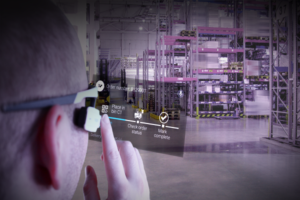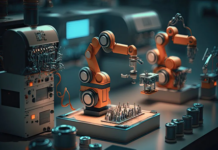
For most people, wearable technology means Fitbits and smartwatches. Experts predict, however, that wearable applications for the workplace — particularly in manufacturing — are likely to have a far bigger long-term impact. Efficiency hits new peaks. Workers turn into superheroes. And big business is investing. Because they’re seeing the logic in dollars and sense. Welcome to the revolution!
In recent years, rapid manufacturing advances have been bumping up against the natural limits of the humans tending the machines. Simply put, our species (unaided) isn’t always up to the task. The good news is we’re not done with humans yet. Smart technology propels us light years ahead, dramatically increasing human capacity to operate at the speed and nuance of the sophisticated precision machinery we oversee.
AUGMENT REALITY (AR) LEADS THE WAY
Put on a pair of glasses and you are suddenly immersed in a new, more informed view, with schematics and data layered into your natural field of vision. Welcome to control central. Interact, by shifting points of focus, tags and alerts dance before your eyes. Drop into further detail or instruction in an instant. And quickly learn to navigate relevant data and protocols with eye movements, voice, or other gestures — without ever having to take your eyes off the scene. It feels completely natural and intuitive.
AR puts the user in charge of automated intelligence. Technicians get the information they need to rapidly monitor and react in real time. Complex procedures transform into manageable tasks. Costly accidents and mistakes dramatically reduce. Everyone at the job site can now see the entire production line with smarter eyes. They can find anything and identify everything — all in an instant — and suddenly recognize the relevance of any anomaly. They can also drill down into as much detail as they need to make a decision or complete a procedure. And — based on what’s in front of them, remote factors they can’t be aware of, and complex logarithmic analysis — they’ll always know exactly what their next step should be. Smart wearable technology guides them through any task. The simplicity and ease of use is stunning. And, firmly affixed to their heads, it leaves their hands free to attend to the job at hand.
At some work-sites, there’s so much information to navigate, it’s hard at times to even know precisely what you’re looking at.
AR’s model-based 3D-object recognition technology overrides the guesswork. In a real-life factory, one thing blocks another. It never looks like it does in the manual. Wearing smart glasses, anyone can see from any angle exactly what that part is and what it’s supposed to do.
The Internet of Things (IoT)
Once upon a time, users manipulated individual tools and devices. Now, increasingly, we’re designing them to work autonomously in concert. Wearable like Augmented Reality (AR) glasses are part of a new generation of evolving smart technology called “The Internet of Things” that is fundamentally changing the way it all works. This is where we’re headed. It’s the future. And, it’s already well underway.
Here’s the snapshot view: Smart chips inside electronic devices distribute the flow of information back and forth across a large network of devices. Engineers design the whole to synchronize, pre-setting all inputs, outputs, and triggers so that every device reacts in real time to every other. The centralized, control-room brain is becoming a thing of the past.Over-all system performance optimizes — more robust, more efficient, and more secure. And everything works better.
WORKERS OPERATE IN THE PHYSICAL WORLD
For humans, AR glasses are a primary sensory interface integrated to other networked sensor and control devices supported by advanced technologies like artificial intelligence (AI) and machine learning. Properly configured, any individual— connected in real time to the intelligence, experience, and resources of the entire organization — can do anything. Where to find something? AR knows. A pointer pops up right before your eyes. What’s the next step? “Remove this screw,” appears, with a circle marking the spot. Which of our experts knows about that? They can be summoned in seconds. With AR, factory or warehouse crew doesn’t have to look hard for answers. It precisely guides them, right within the frame of their vision.
Human-centered design is crucial for success. Hand-held monitoring and control devices are impractical for technicians, like welders, who need to hold equipment in position. AR glasses empower them. Spoken commands or simple eye movements make it easy to adjust control and navigate relevant technical manuals and tables, all at the same time. A live data stream can trigger alerts, pointing technicians where to look for potential problems as they arise. All contextually relevant labels and directions automatically follow, as they work through a procedure. Or recommended mechanical adjustments can simply activate autonomously.
Quality Assessment
AR can also help on-site workers maintain consistently high quality in manufacturing output. Monotonous routines naturally desensitize us to nuanced variations. It’s a fact of nature. The human brain fills in the gaps of what we don’t see with imaginary projections of what we think is there. It’s not just human error. Natural materials misbehave. Perfectly engineered and machined mechanisms drift out of alignment. In most manufacturing facilities, perfection is a myth. Deviation in product output is a given. The real question is: when is it good enough? A well-designed AR system takes command, countering the numbing drudgery of information overload by radically reducing flow to only what’s most relevant. The on-site team is empowered to notice what they need to.
AR enables a team to compare any object they see on the production line to its optimal state. They’ll be able to instantly measure it against the original plan, specs, and acceptable standards of deviation. The integrity of complicated curved objects, like auto parts, can be quickly assessed — or potentially even an entire assembly line or a collection of micro-components scheduled for shipment. Every item can be viewed overlaid directly with 3D diagrams, making it easy to spot micro-flaws and degradation on the factory line and in the field, before it’s a crisis. With additional tools, engineering tolerances and torques can also be spot-checked. What to look for is specific to each design. AR can show you — and tell you exactly when it doesn’t cut the mustard.

Sometimes you can fix the problem. For complex inspections and repairs, AR can guide your techs with a kind of X-ray vision deep into the inner workings of your products, components, and machines. AR-assisted guidance vastly simplifies any procedure. In one recent study, those wearing AR glasses for just the first time performed repairs 34% faster.
As efficiency experts analyze the specific needs of their operations and innovators gear up for new challenges, every new use case spawns a dozen more. Wearables rise to the opportunity every time, enabling workers at all stages of manufacturing to accomplish the impossible.


















